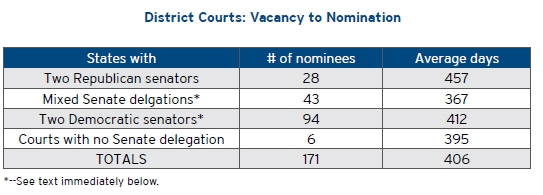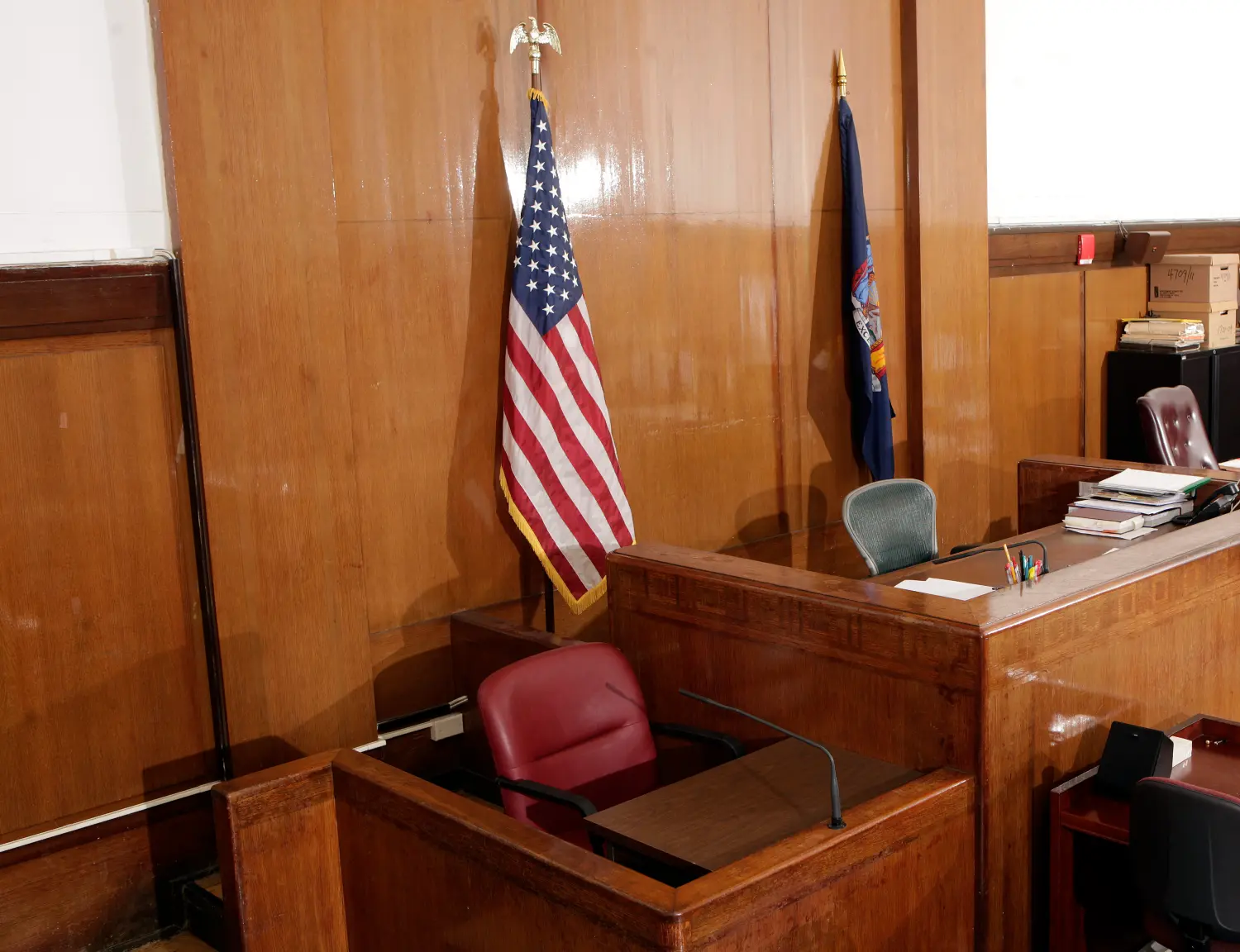Last week, Senate Judiciary Committee ranking member Charles Grassley (R-IA.), said “we hear a lot about the vacancy rates. There are currently 86 vacancies for federal courts. But of course, you never hear the President mention the 62 vacancies that have no nominee. That is because those 62 vacancies represent nearly 75 percent of the total vacancies.”
This brief paper, after noting the considerable power that home state senators have over judicial nominations, reports that:
- Considerably fewer of the vacancies without nominees on April 12, 2013, could reasonably be expected to have had nominees by then, based on patterns in the previous two administrations.
- Of the vacancies without nominees, almost half are in states with two Republican senators, and those vacancies are older than those in other states.
- There are many more nominee-less vacancies now than at this point in President George Bush’s presidency.
- Of the vacancies that have received nominations, the time from vacancy to nomination was greater in states with two Republican senators.
- Although it is difficult to apportion responsibility for the number and age of nominee-less vacancies and the longer times from vacancy to nomination, we should consider a specific proposal for more transparency about pre-nomination negotiations that might produce more nominations, more quickly.
The Senate has long honored the concept of “senatorial courtesy”—a willingness to confirm judicial nominees only if the home state senators approve. Senate Judiciary Committee chair Patrick Leahy and most of his predecessors over the last half-century or more have refused to process nominees to whom home state senators have objected, although the form of the objections and the weight given to objections from majority and minority senators has varied.[1] This year, even the Senate majority leader couldn’t get a hearing for a Nevada state judge whom he had recommended, because his Republican colleague refused to let the nomination proceed. Home-state senators’ effective veto over judicial nominees leads to bargaining—how much currently, we outsiders can’t say—between the White House and home state senators to find nominees that the administration favors and that the home state senators are willing to let proceed. The practice now seems to be, in general, that senators propose district nominees to the White House and react to potential court of appeals nominees proposed to them by the White House.
Number and age of vacancies without nominees
As of Friday, April 12, 2013, 71 actual and future vacancies on the district courts did not have nominees before the Senate, nor did 13 court of appeals vacancies. (A “future” vacancy refers to a judgeship occupied by a judge in active status who has announced publically that s/he plans to leave active status at some future date. The Judicial Conference of the United States encourages judges to give a year’s notice of their intention to leave active status, but not all judges do so.)
Only 33 of the 71 district vacancies, however, and nine of the appellate vacancies occurred or were announced before the August 2012 recess. For this and the previous two administrations, vacancies occurring after those fourth-year recesses have not received nominations until mid-April or later of the fifth year, except for one of President Barack Obama’s nominees.[2] The 33 district and nine circuit vacancies also exclude those that became nominee-less when, after the August recess, a nominee withdrew or was not resubmitted. (For example, the Nevada nominee referenced above asked the president to withdraw her nomination on March 13, 2013. Although the president had nominated her in February 2012 for a vacancy created in August 2011, the new date of the vacancy is the date of the withdrawal, and, for that reason, is not one of the 33 district vacancies.)
District vacancies
The table shows that of the 32 vacancies in district courts with Senate delegations, almost half—15—were in the 14 states with two Republican senators—including six in Texas, three in Georgia, and two in Kentucky.

Eight of the vacancies are in the 18 states with two Democratic senators, including three in California and two in New York. Nine are in states with a mixed delegation, including two in Illinois, three in Pennsylvania, and two in Wisconsin (and one in Massachusetts that was announced three and a half years ago, when the state had a mixed delegation, even though the delegation reverted to all Democratic in January 2013). These 32 nominee-less vacancies include three that once had a nominee who dropped out—two in two-Republican senator states and one in a split-delegation state.
The nominee-less vacancies in the states with two Republican senators are considerably older than those in states with two Democratic senators—measured in average days from the vacancy date, here defined as when it was announced, when it was created if no announcement, or Inauguration Day for vacancies that Obama inherited. Average age of the district vacancies in states with two Republican senators is 672, versus 649 for states with mixed delegations, and 471 for states with two Democratic senators.
Court of appeals vacancies
Court of appeals judgeships are not statutorily assigned to particular states within the circuit but strong and rarely disputed traditions dictate that each judgeship belongs to a particular state.

Of the six nominee-less appellate vacancies in states with Senate delegations, four are in states with two Republican senators (Georgia, Kansas, and two in Texas). One is in Wisconsin, where the incoming Republican senator made clear in early 2011 that he would veto a nominee whom the administration first submitted in 2010 and resubmitted in 2011. The Kansas vacancy also had a nominee who dropped out after the two senators would not allow the nomination to proceed. The other is a vacancy on the Ninth Circuit’s Court of Appeals—the oldest vacancy in the country—that has been the object of one of the rare interstate disputes over the seat’s proper location, this one between the California and Idaho Senate delegations. (The 1,543 days shown are from the 2009 Inauguration Day; the vacancy dates to 2004.)
The average age of the four nominee-less appellate vacancies in the judgeships from states with two Republican senators is 529 days and much longer for the Wisconsin vacancy.
Bush Administration Nominee-less Vacancies in April 2005
The current situation is different, certainly as to the district courts, than the one that prevailed early in President George W. Bush’s second term, as shown on the table below, indicating pre-2004 recess vacancies that had no nominees by mid-April 2005, and the days that had elapsed since the vacancies’ creation or announcement.

In 2005, there were five nominee-less district vacancies, as opposed to 33 now, in part because the Senate had confirmed 97 percent of Bush’s pre-recess district nominees, as opposed to 90 percent of Obama’s, and Bush submitted only three nominees from the recess through mid-April, versus 15 by Obama. The three nominee-less appellate vacancies are three fewer than the current six vacancies in states with Senate delegations. Two were in California, one a vacancy for which the administration did not resubmit its initial 2013 nominee due to the home state senators’ objections. The extended vacancy reflected in part a dispute over whether the judgeship belonged to Maryland or Virginia.
Time from vacancy to nomination
What about judgeships that got nominees, whether confirmed or not? The table below shows the total number of Obama district nominees as of April 12, 2013.

On average, the Obama administration has submitted its 171 district nominees 406 days after the date of vacancy. The average for the 28 nominees in states with two Republican senators was 457 days, compared to 412 for the 94 two-Democratic senator state nominees and 364 for the 43 split-delegation state nominees. These figures, though, show the analytical difficulties created by changes in the make-up of Senate delegations; three long-pending Pennsylvania nominations could be ascribed to either the mixed or two-Democratic group. I have ascribed them to the latter, but ascribing them to the former would increase the average days for mixed delegation state nominations to 419 and reduce those for two-Democratic states to 387.[3]
There was considerable variation within the three categories. The six Texas nominees waited on average 603 days from the date of vacancy (as defined above), while the four in South Carolina waited only 286. The nine in Florida, with its mixed delegation, waited 353 days. The two Pennsylvania nominations clearly ascribed to the mixed delegation group waited 665 and 850 days, while the three I ascribed (almost by a flip of the coin) to the two-Democratic category waited 1,152 days on average. The 20 New York nominees waited 399 days on average, and the six in Illinois when it had two Democratic senators waited 275 days.
Average days for making circuit nominations were lower in all categories. There were not enough nominations for individual states to identify reportable variations.

What explains these differences?
We can only speculate, but no doubt both the Obama White House and at least some of the senators bear some responsibility for the high number of long-lasting nominee-less vacancies, and the long times from vacancy to nomination. The 391 days on average from date of district vacancy to nomination in two-Democratic senator states under Obama is longer than the overall time for all nominations under Bush to this point—276 days on average (At this point, Bush circuit nominees had waited on average 300 days for nominations.)
Perhaps the Obama White House has been slower to suggest potential nominees in states with Republican senators, or react more slowly to suggestions from those senators. Perhaps Republican senators insist, more than their Democratic counterparts, on nominees they proposed over White House objections or object more to White House-proposed nominees. The entire Senate Republican caucus told the White House by a March 2009 letter that “if we are not consulted on, and approve of, a nominee from our states, the Republican Conference will be unable to support moving forward on that nominee. . . .”[4] Perhaps Democratic senators from mixed-delegation states are the hold-ups, or perhaps Democratic House of Representative delegations have also stymied quick nominations by insisting that the White House pay attention to them as well as to their Republican senator counterparts.
Because we can only speculate on White House-senator negotiations, consider the proposal by Columbia Law School’s Michael Shenkman, a former Senate Judiciary staffer who later worked in the Obama administration. He has proposed that White Houses publish “the status of pre-nomination negotiations, although not the names of the [potential] nominees themselves.”[5] Senators could call out what they regard as misleading administration information, bringing the dispute into the open for verification. All in all, “[l]ocal editorial pages across the country would be newly equipped to comment on who is holding up the filling of” vacancies.[6] (Shenkman’s proposal is aimed at district vacancies, because his main objective is to try to fix the somewhat more fixable district judge confirmation process. Restricting the greater transparency proposal to potential district nominees may be the best way to inject any transparency into the process at all. The proposal, though, may merit consideration for court of appeals vacancies as well.)
The form of disclosure would resemble the Administrative Office of the U.S. Courts’ on-line list of “Current Judicial Vacancies,”[7] from which I have drawn some of the data for this short analysis. It displays the vacancy and the date it was actually created, the previous incumbent, the name of any formally submitted nominee, and the date of the nomination. The administration Web page would add to this information, for each vacancy without a nominee, the date on which the incumbent gave notice of the forthcoming vacancy or the date the vacancy was created in the absence of such notice, the date when the White House received senators’ recommendations, and an administration statement on whether it is still considering the unnamed, potential candidates or whether the administration has requested new names.[8] Where the administration initially provides names to senators for comment, the list could identify the date the names were provided, the date of any senatorial response, and, again, whether the administration is still considering the candidates. The administration list, to repeat, would include no names except those of the previous incumbents and those of nominees formally submitted to the Senate.
Shenkman acknowledges that candidates submitted to the White House who are identified in senatorial press releases or by the rumor mill could be embarrassed if they do not get the nomination, but argues the “[a]dministration’s priority should be on the health of the overall process.” Senators might not like the light such a list would shed on their dealings with the White House, but Shenkman argues that it would be difficult for senators to frame a principled objection to such disclosures, which could help repair the overall process.
* * *
At the least, such a public list (and any disputes over its accuracy) would shed more light on the vacancy situation than merely counting the number of nominee-less vacancies.
Download the full paper »
[1] See M. Sollenberg, The History of the Blue Slip in the Senate Committee on the Judiciary, 1917-Present (2003), http://wikileaks.org/wiki/CRS-RL32013 . Thanks to my colleague Sarah Binder for calling this document to my attention and for her comments on the phenomenon at issue.
[2] In February, Obama submitted a nominee to a vacancy announced in mid-August on the (senator-less) Court of Appeals for the Federal Circuit.
[3] The three dates of vacancy were in early to mid 2009, when the state had two Democratic senators after Arlen Specter’s switch in April 2009, and persisted through the almost two years of the two-Democratic delegation until nominations in mid-and late 2012, when the state had had a mixed delegation for over a year and a half.
[4] Manu Raju, “Republicans Warn Obama on Judges,” Politico, March 2, 2009, available at http://www.politico.com/news/stories/0309/19526.html.
[5]M. Shenkman, Decoupling District from Circuit Bench Nominations: A Proposal to Put Trial Bench Confirmations on Track,” 65 Ark. L. Rev. 217, at 299 (2012).
[6] Id. at 302.
[7] See star note at p. 1.
[8] Shenkman, op cit at 300.
The Brookings Institution is committed to quality, independence, and impact.
We are supported by a diverse array of funders. In line with our values and policies, each Brookings publication represents the sole views of its author(s).



